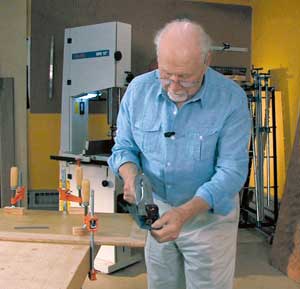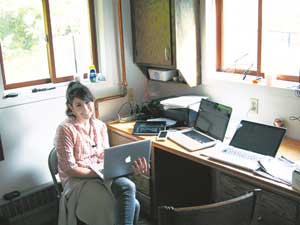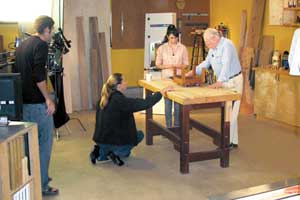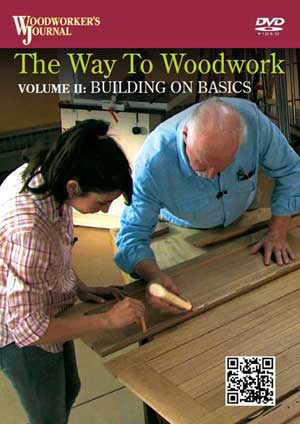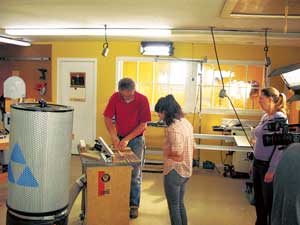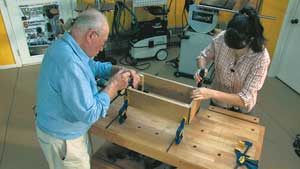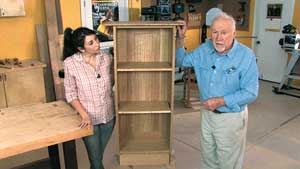
Starring in the new DVD series from Woodworker’s Journal, The Way to Woodwork, are Ian Kirby and LiLi Jackson.
Ian, a long-time U.S. resident who emigrated from Great Britain decades ago, is the guiding force behind the instruction and the philosophy of woodworking that’s presented in the DVDs. “It’s the methodology that I’ve been harping on about for as many years as I’ve been working for Woodworker’s Journal,” he explained.
For over a decade, Ian has been a regular contributor to the Woodworker’s Journal print magazine, writing articles on topics ranging from wood science to project design, as well as specific projects. In all of the articles — and on the DVDs — he puts to use the training he himself received in the British Arts and Crafts tradition. His studies included lessons with Edward Barnsley, son of one of the members of the original British Arts and Crafts movement.
“I didn’t ever give it a second thought that somebody else could take this role” on the DVDs, Ian said. “It dealt with a logical methodology of furniture making as produced by the hand furniture makers of the Arts and Crafts movement.”
“It’s a whole process that takes you from beginning to end,” LiLi Jackson added, “not just one technique or one tool.
LiLi, the daughter of Woodworker’s Journal founder and Rockler Woodworking and Hardware CEO Ann Rockler Jackson, is also a woodworker in her own right who has studied at a variety of woodworking schools across the country. Unlike taking a class on a specific technique or project, of the DVD series, she said, “It’s really comprehensive,” organized in a specific manner. “I think just watching it myself, and rewatching, I’ll learn more.”
She also noted that she had managed to learn some different techniques from Ian during the course of filming itself. For hand tools, it might have been a different way to hold it. As for power tools, “I would often use the router table to cut rabbets and dadoes and whatever. I would try to avoid the table saw as much as possible. He [Ian] would say, ‘This is the most efficient way; this is the way you’re going to do it.'”
While woodworking, Ian said, can encompass anything that changes the form of wood, such as, for example, putting up an outdoor fence, in the DVDs, “Fundamentally, what we’re talking about is furniture making. I would hope that this would give a clear message that there is a methodology to furniture making.”
There are also methodologies to filmmaking, and the experience this time, Ian said, was different from the instructional videos he’s filmed in the past: “It’s the difference between the BBC and Hollywood.” For the British Broadcasting Corporation, he said, the attitude is, “You practice it, you should know what you’re doing. Hollywood will do take and take. On the previous occasion, we mapped out what I was going to talk about, there were cameras on me and they said go, and I just talked and demonstrated. In this instance, there was retake and retake. It was much more organized and broken into smaller bits.”
Also, he said, “The sound guy had a very important part to play. It’s quite extraordinary how sensitive the sound guy gets with the equipment: sounds that were off the set, that you could barely hear, he’d say, ‘We’ll have to wait until that passes.'” With summer rainstorms, LiLi said, “We would lose a half day to shoot because of the sound on the roof.”
Additionally, Ian said, “An abiding memory was the determination to try and keep the sequence so that everything in the background is the same in one shot as it was in the previous one.” That experience with the importance of continuity in film sequences has made him more aware of it as a spectator — he noted that his recent viewing of a George Clooney movie had him noticing “how out of sync Clooney frequently appears” when viewing his five o’-clock shadow. On The Way to Woodwork set, shot largely in a shop belonging to Woodworker’s Journal editor in chief Rob Johnstone, “Matt [Becker, WJ internet production coordinator] was particularly good at keeping the set so that it looked alike,” Ian said.
LiLi had her own comment about stability on the set: “Rob’s saw is on wheels, and we would move it in and out of the shop for different scenes, and someone would forget to lock it down. I’d be going to rip a board, and the table saw would move away from me: not cool. I’d tell everyone, ‘Your stationary tools should remain stationary at all times.'”
In addition to on camera talent like Ian and LiLi, others present on the set included Woodworker’s Journal editor in chief Rob Johnstone and director Robert Jackson: “My father’s the director,” LiLi said, “and my mother’s the executive producer.” Her brother, A.J. Jackson, provided the music. “Even in a professional situation, people are still your parents,” LiLi said. “My mom would make some comment about how my hair or outfit looks; she’d definitely see it as a mom sometimes.”
For his part, Ian said, “My sole goal was to satisfy Rob, because I saw Rob as the guy with the vision and knowing what he wanted. Everybody else was simply putting it together.”
Others might disagree. “In a way, it’s kind of Ian’s story,” LiLi said of The Way to Woodwork. “Working with Ian is so amazing. He knows everything.” In the course of their working together, “he’s become a mentor and a friend,” she said, who has had an influence on her decision to pursue graduate studies in industrial design.
“Ian really talks a lot about how many woodworkers don’t understand design,” she said. “They may be talented woodworkers, but with not understanding concepts of design and aesthetics, their joinery might be heavy.” He addresses the topic of design on the DVDs, and “he’ll add little things to make it more appealing, like maybe add an inset to change the way your eye goes,” she said.
The DVD series name “The Way to Woodwork” plays off the Julia Child book The Way to Cook — many of those involved in the production enjoying cooking. “Just as that’s a classic, we hope this becomes a classic, and hope it inspires people,” LiLi said. “The whole point is: there isn’t a fresh perspective. It’s the best methods that have been handed down for generations.”
